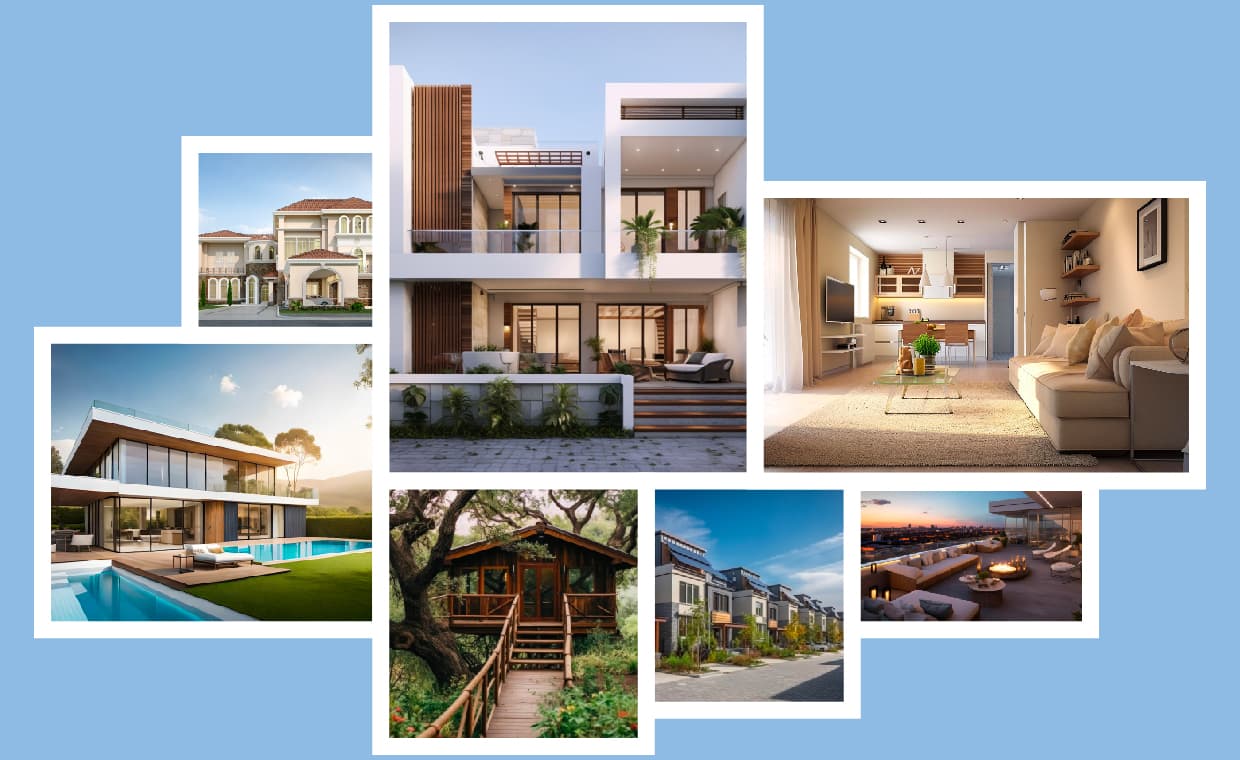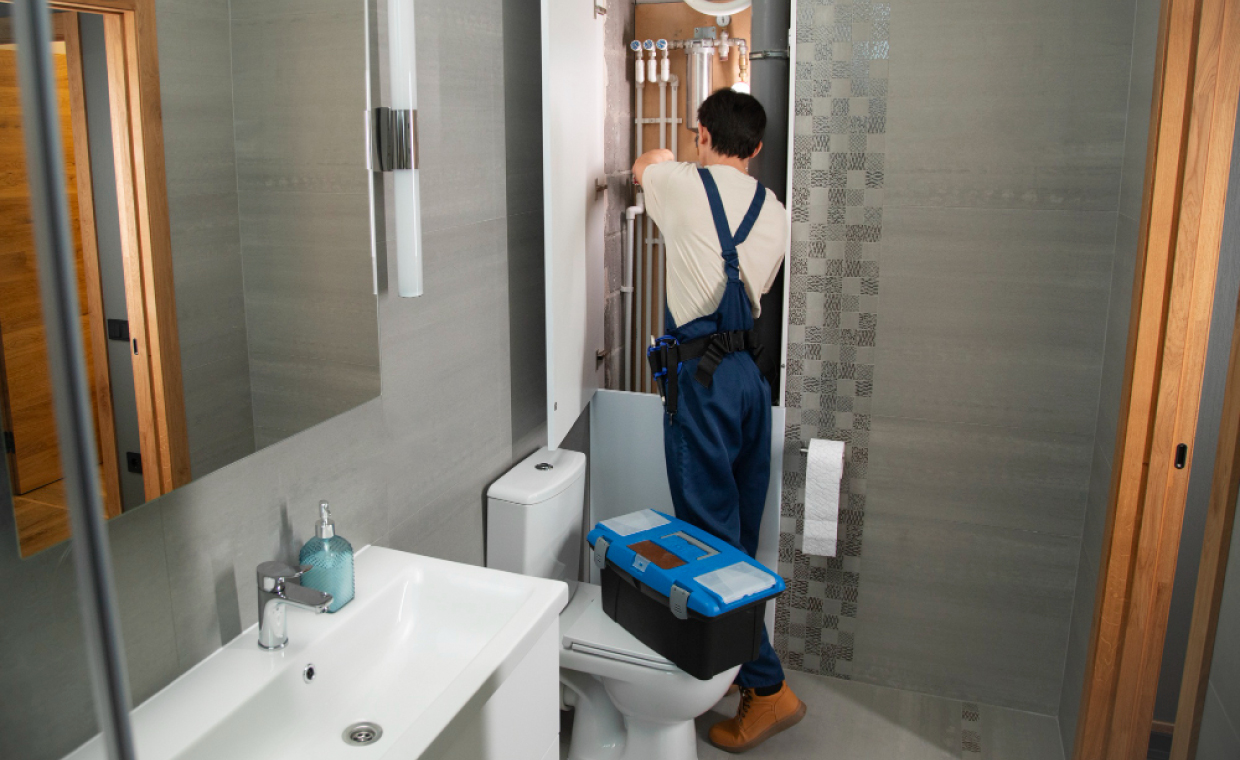
Are You Keen To Explore Various Types of Houses In India?
India is a country known for its rich cultural heritage and vibrant diversity. Regarding housing, it boasts a fascinating array of architectural styles that vary according to its geographic location. The various types of houses in India represent the country’s blend of traditions, regional influences, and evolving trends.
Exploring these Indian homes, from ancient traditional dwellings to contemporary urban residences, the housing in India showcases a diverse variation of lifestyles, cultural practices, and architectural marvels. These vary according to the geographical location, the climate of the region, building materials, architectural influence, lifestyle, and the financial status of the people.
So, let’s begin the journey of exploring Indian homes, wherein each type depicts its own story.
Various Types of Houses in India
Let’s explore various types of houses in India in detail:
01. Flats or Apartments

A flat or an apartment is the most preferred and affordable housing for the middle-class and upper middle-class population. A single apartment building consists of several flats on one floor. Each flat consists of living room, kitchen, bedroom, bathrooms and balconies, which allows family to live comfortably. Flats are 1BHK, 2 BHK, 3BHK or at times bigger than these. The scarcity of land in metropolitan cities has led to the rise in apartments.
02. Studio Room

A studio room is a self-contained apartment or a small dwelling wherein the normal functions of a room including a living room, bedroom, and kitchen are combined into a single room. It is gaining popularity these days. They are compact and efficient, making them popular among working people and students.
03. Penthouse: Top Floor Luxurious unit

Penthouses are luxurious top-floor units in the multi-storeyed building. It is one of the most expensive apartments in a building because they are the largest and most luxurious homes within a building, offering the most breathtaking views. They have high ceilings and are spacious and lavish, with private access to the terrace, zero disturbance, and access to amenities like a swimming pool by the residential project.
Dive deeper to know the pros and cons of living in a penthouse.
04. Bungalow

A bungalow is an independent one-storeyed or two-storeyed house, typically found in semi-urban areas or countryside. It has a large verandah. With the rising technology, many homeowners use advanced architecture and modern amenities to blend with the urban lifestyle. It houses one family to enjoy the personal space with a garden and parking space. They are designed as per the tastes of homeowners in varied styles like traditional, contemporary, and modern style architecture.
05. Villa

Villas are the most luxurious types of houses in India that come with top-notch amenities. It is a spacious residence offering privacy accompanied by recreational amenities like lawns, backyards, swimming pools, clubhouses, and theatres. The outskirts of cities provide enough area for the construction of these villas within gated communities. Those seeking independent living prefer this setup.
06. Condominium

A condominium or a condo is a type of house within a building that contains several individually owned apartments with jointly owned common areas like a clubhouse, swimming pool, playrooms, and outdoor areas. Condominiums have recently gained popularity in a few cities in India.
A condo is individually owned but under the umbrella of a condo group homeowner’s association, and other common areas of a condo are usually maintained by the association of homeowners.
07. Cottage

A cottage is a small single-storey house with a front porch and thatched roof. It is typically located in the countryside and built with natural construction methods like stone, thatched roofs, stucco walls, mud, and clay. Cottages are popular as holiday homes near beaches, lakes, mountains, and deserts like Goa, Ooty, Nainital, etc.
08. Row Houses in India

A row house is an independent house built within a gated community. The architectural design for all the row houses is identical. One can combine the design of a bungalow and a flat in a row house. It provides the benefits of independent living while staying in a community.
09. Duplex

A duplex is a type of house in India that comprises two residential units, one above the other. It has residential units covering two floors connected by a staircase, with a kitchen and a common area. It is a stylish and independent type of house ideal for joint families wherein everyone lives under one roof while maintaining privacy.
10. Farmhouse

A farmhouse, as the name suggests, is a type of house surrounded by a farm. People looking for holiday homes love farmhouses. A farmhouse has more space to relax in the lap of nature, host parties, and grow veggies. It is a perfect space for fitness freaks. The architectural style for a farmhouse varies from classic to traditional to modern.
11. Tree House

A tree house, as the name suggests is built on a tree with materials like bamboo, leaves, and concrete materials. They are popular weekend getaways furnished with modern amenities. It is usually found in forest areas. You can feel the fresh air in the lap of nature. Tree houses are a great way to enjoy the beauty of forests.
12. Hut

A hut is the most basic type of house in India, mostly found in rural areas, built with locally available materials like wood, stone, grass, and mud. These tiny dwellings are simple and cost-effective, found in tribal areas of India.
13. Palace

Palaces are magnificent homes of the former Indian maharajas. The splendid architectural styles of palaces depict their lavish lifestyles. Most of the palaces have now made way for heritage hotels.
14. Eco-Friendly House

An eco-friendly house aligns with the environment, and energy-efficient materials, while in construction and while in use. Eco-friendly homes have thermal insulation to reduce electricity consumption and carbon emissions. Designing the houses with sustainable technologies helps minimize environmental impacts.
Types of Traditional Houses in India
Traditionally, houses have evolved in response to local climate, topography, and culture. Traditional Indian houses vary according to different states since they are built with locally obtained materials and indigenous construction techniques. The most common materials are stone, brick, mud, wood, lime, and thatch.
Let’s have a quick look at some classic Indian dwellings.

The Nalukettu, Kerala’s traditional great house, consists of four blocks connected by an open courtyard, whereas the Ettukkettu is an eight-block construction. These residences were constructed in accordance with the principles of traditional Thachu Shastra (the science of Architecture) as well as Vaastu shastra.

The Guttu home of the coastal Karnataka is a typical Bunt community house. These steeply pitched roofed residences incorporate two-story blocks around a courtyard and include several hardwood ceilings, elaborate pillars, and carved doors. The design resists the harsh summer weather and frequent rainfall. The building materials are clay and oak. Paddy fields and palm trees flank the Guttu homes.

The Mughal, Persian, and Indian architecture inspire the traditional house design of Rajasthan. These houses are called Havelis. They are traditional houses with lovely courtyards and intricately constructed jharokhas, patterned floors, and carved pillars. Sandstones, marble, wood, plaster, or granite are used to construct Havelis.

The traditional style of dwelling in Kutch, Bhungas, is the product of topography and terrible climate. These spherical mud dwellings in Gujarat have a thatched roof. They are well-known for their structural stability during earthquakes as well as their resistance to climate change.

Wada is the traditional dwelling of Maharashtra that represents rich architectural heritage. A form of housing that reflects the pride, culture, traditions, and turbulent history of Marathas. Wadas are preserved as architectural heritage.

The one-story houses with verandas provide relief from the humidity of Bengal’s summers. Bungalows are distinguished by their slanted roofs, open floor designs, wide windows, and board front porches. The term “bungalow” comes from a Hindi phrase that means “a house in the Bengali style,” and it entered English during British control in India.

A stilt house, also known as Chang Ghar, is typically found in flood-prone areas like Assam, specifically designed with bamboo. They are a few feet above the ground to prevent the occupants during floods. The raised structure prevents water from entering the house.
Summing up
India is a diverse country with varied types of houses depending on its geographic location, the climate of the region, construction materials, architectural influence, people’s lifestyle, and financial conditions. However, in response to changing trends and cultures, architectural styles of houses have evolved with time.
FAQs
01. What exactly is a Kutcha House?
A Kutcha house is a form of building with walls composed of bamboo, mud, grass, reed, stones, thatch, straw, leaves, and unburnt bricks. One can see these structures in rural areas and in cities where labourers construct make-shift dwellings.
02. Where can you find Houseboats in India?
Kerala and Kashmir have houseboats. Kettuvallam is a typical Kerala houseboat found in Alappuzha, Kollam, and Kumar Akom. Traditional houseboats can be seen in Kashmir on Dal Lake in Srinagar. Rooms, a kitchen, and a balcony are standard features on all houseboats.
03. Why are gated communities so popular in India?
A housing society is a gated community that includes flats or even villas as well as community amenities such as swimming pools, parks, and gyms. Houses in gated communities are in high demand in cities because they provide a high-quality lifestyle and security.
Image Courtesy : Image 7, Image 14, Image 16, Image 17, Image 18, Image 19, Image 20






























